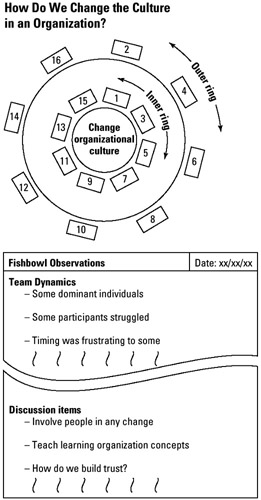Tool 76: Fishbowls
| AKA | Team Talk |
| Classification | Team Building (TB) |
Tool description
Fishbowls are very structured and facilitated discussions on some problem or issue by half of the team's participants while the other half of the team observes the process. After a predetermined time period, both halves switch roles. Fishbowls are ideal for team dynamics to serve as team training, as well as to explore in-depth an issue or problem.
Typical application
-
To train teams to communicate effectively, have discussions among equals, and promote an open sharing of ideas.
-
To keep participants focused on an issue or problem.
-
To start a problem-solving effort.
-
To observe and analyze team dynamics.
Problem-solving phase
| → | Select and define problem or opportunity |
| → | Identify and analyze causes or potential change |
| → | Develop and plan possible solutions or change |
| Implement and evaluate solution or change | |
| Measure and report solution or change results | |
| Recognize and reward team efforts |
Typically used by
| Research/statistics | |
| 1 | Creativity/innovation |
| Engineering | |
| Project management | |
| Manufacturing | |
| Marketing/sales | |
| Administration/documentation | |
| Servicing/support | |
| Customer/quality metrics | |
| Change management |
before
-
Sociogram
-
Buzz group
-
Observation
-
Circle response
-
Circles of influence
after
-
Rotating roles
-
Different point of view
-
Consensus decision
-
Critical dialogue
-
Presentation
Notes and key points
-
Ensure that participants switch roles only as directed.
-
Each participant's input is limited to 1 minute per input.
-
Total time for the fishbowl activity is 60 minutes.
Step-by-step procedure
-
STEP 1 The facilitator provides an overview of the fishbowl process. Participants draw numbers and are divided into odd and even numbers. At the beginning, the odd-numbered participants are seated in the inner circle, the fishbowl. Even-numbered participants take a seat in the outer circle.
-
STEP 2 Next, the facilitator displays the issue to be discussed, informs the inner ring when the discussion starts and that they have 30 minutes to discuss the issue. A moderator is selected and receives a prepared set of questions to keep the discussion stimulating and challenging. Participants are asked to keep their input to 1 minute per issue. The moderator takes notes on the discussion for team sharing. See example How Do We Change the Culture in an Organization?
-
STEP 3 The participants of the outer ring are assigned roles as observers. Their silent note taking will capture data on conflict, interruptions, drifting to other issues, dominant or less expressive participants, and other situations.
-
STEP 4 The facilitator starts the clock and the discussion and observations take place. After 30 minutes, the fishbowl is stopped and the observers provide feedback on their observations.
-
STEP 5 Roles are switched and the outer ring participants (even numbers) move to the inner ring. Steps 2 through 4 above are repeated to complete the fishbowl.
-
STEP 6 Both moderators share their discussion notes and a joint discussion may now take place on the issue, as shown in the example.
Example of tool application

EAN: 2147483647
Pages: 326